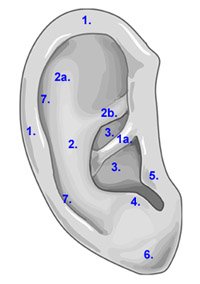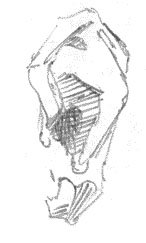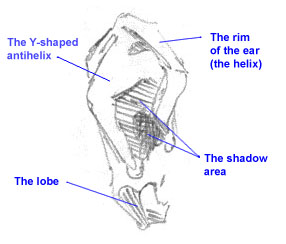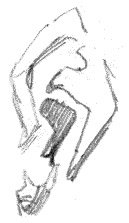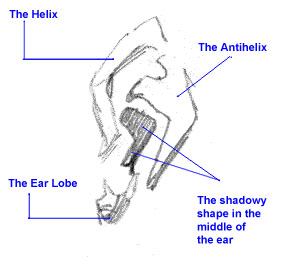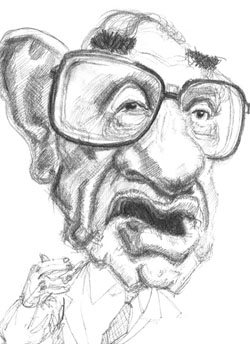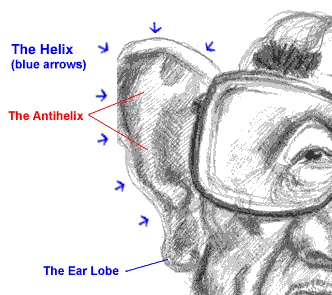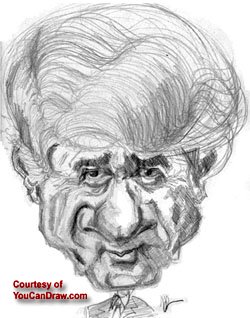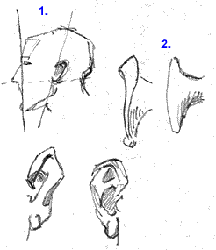|
of a total approach to drawing faces |
|
| Ear Anatomy |
|
|
More on the parts of the ear 1. Helix: this is essentially the rim of the ear. 2. The Antihelix is the whole "y" shaped thing in the center of the ear. Fun fact: this y-shaped folding of tissue forms late in the third trimester while you're still in your mother's womb and serves to both stiffen the ear and keep it from sticking out into space where it'll get traumatized or injured flapping in the breeze like an elephant's ear. 2a is the superior crux of the antihelix and 2b is the inferior crux of the antihelix (Medically speaking "superior" means above in space, and inferior means below - it's not a statement about social importance or anything like that. For example, your nose is superior to your upper lip - that is, it's placed physically above it. "Crux" means cross.) 3 is the part of the ear called the "concha". What else is called a concha? If you thought of the big seashells you put over your ear to "hear the ocean", you're on the right track. This is exactly where the name comes from. And the shape is similar: a big concavity that helps focus the sound right into the opening of your ear (the meatus) which, incidentally, isn't labeled here. 4 is the "antitragus" - a little extra bud of tissue at the junction of the ear lobe (6) and the tail of the antihelix. Across from the antitragus is it's complement: (5) the tragus. The tragus is that stiff rounded piece of tissue that juts out bravely just behind your jaw bone and just above that soft fleshy spot where you'd get the mumps if you didn't get your shots growing up (the parotid glands). Lastly, (7) is the Scapha. This is the little depression, the scooped out area at the back edge of the ear between the antihelix and the helix.
A right ear
You don't have to know all this to draw ears! But do you really have to know all that to start? No. Knowing a few facts about it though makes it a little more interesting and consequently, easier to to remember. But you don't have to know all the names to start. In fact I think the ear can be broken down into four basic parts for the sake of rapid fire representation. These four parts are:
Learn to see those four parts and you've got the battle pretty much won. You can always fine tune later. Graphically, here's a right ear with these four parts labeled:
Squint your eyes and try to recognize the four different major
Here's a partially blown-up picture of the ear with the four parts easily recognizable (quick quiz: which ear is this? Correct, it's the left):
A partially blown-up ear-- blown up
And just for posterity's sake. Let's re-label all those same parts of our partially blown-up left ear (repetition helps this sink in):
|
| Ready for a quick little quiz? Sure you are :-) Try this: Here's what you do: go look for what you've just been exposed to. Here's a penciled caricature of Alan Greenspan. Q: Can you identify these four parts of the ear?:
The honorable Alan Greenspan And which part of his ear got slightly chopped off by the border around his picture? (Talk about budget cuts!) Did you correctly guess the helix? Alright! You're studying and it's paying off. :-)
Again, squint your eyes to see drawable parts (the shadow shape is
[Answer to bonus points #5: Proportion is a measure of relationship. You know that both the left and right halves of the glasses are pretty much the same size. Yet, in this picture you can see the half of the glasses closest to you (the half on the left side of the picture) are much bigger than the half on the right. This is an effect of perspective: the farther away something is, the smaller it looks. If Mr. Greenspan were looking straight at you rather than being rotated the way he is here, both halves of the glasses would look proportionate - you'd see them as the same size. Also look at the eyes. Notice how the eye farther away is proportionately smaller? In fact when two objects are the same size but one is farther away than the other there's a mathematic relationship between it's perceived size and it's actual size. But all you have to be is aware of is the fact that distance shrinks.] One more quick quiz: Can you also see the different parts of the ear in this caricature of Mr. Ted Koppel? The four main drawable parts are pretty well hid by that abundant Koppel hair-do (and also because his ears are drawn pretty flat). No extra help on this one - go for it, you can recognize and name the parts:
Mr. Ted Koppel
Before I send you off to draw an ear or two, check out this last drawing and be aware of how the ear appears when viewed from different angles and be cognizant of it's placement on the face.
1) One shows you two things: the nearly vertical lines show you how the ear and the front plane of the face line up. And secondly, you can also see the dotted horizontal line which demonstrates how the bottom of the ear and the bottom of the nose align. 2) Number two shows you the ear viewed from behind and it's approximate funnel shape (the shape closest to the right hand border is the funnel; the next shape to the left is the ear as it might appear when viewed from behind. (Question: what parts of the ear are most visible viewed from behind? Ans: The helix, the lobe and the basin of the ear - which we haven't mentioned - but it's really the area that forms the shadow shape of the ear when you view the ear from front and side.) Want to try drawing and ear just for fun?
You get to draw this ear! Not to worry, just use what you've learned in the first sections on the basics of drawing. Click here to review: Drawing Basics I Click on this next button for a left ear with a grid pasted right over it:
Click here to see this ear with a grid:
And here's your empty grid. You'll need it to draw the two ears from above. Print it out a few copies for either ear and dive on in! (Make as many copies as you like - get lot's of practice and soon you'll have the parts of the ear committed to memory and you'll find yourself finding them on every one you see :-).
|

